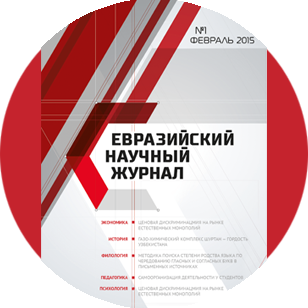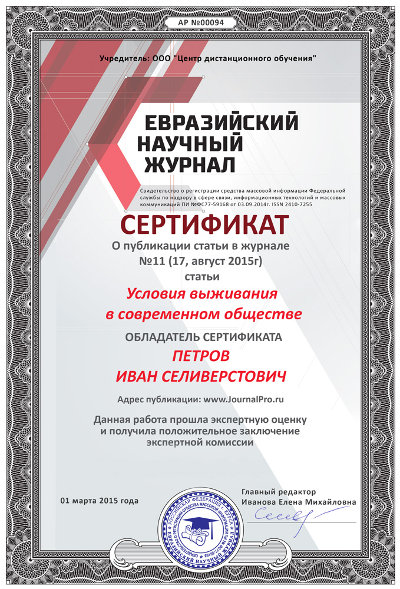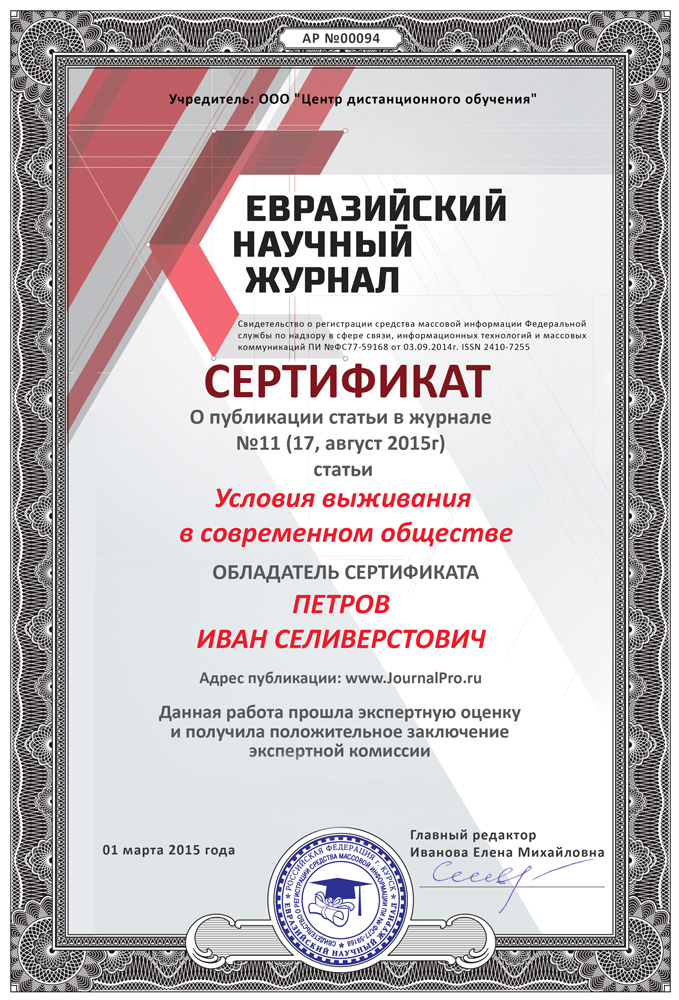Срочная публикация научной статьи
+7 995 770 98 40
+7 995 202 54 42
info@journalpro.ru
The French national Constitution Assembly
Рубрика: Исторические науки
Журнал: «Евразийский Научный Журнал №2 2017» (февраль, 2017)
Количество просмотров статьи: 3636
Показать PDF версию The French national Constitution Assembly
MM.Ashwaq Salem Ibrahim Al-Doury
University of Samarra
College of Education
Department of History
scition titie: Teacher Assis
E-mail: thelelushlamberg@gmail.com
ABSTRACT
The history of France’s Parliament over the last two centuries is closely linked with the history of democracy and the chequered path it has followed before finding its culmination in today’s institutions.
The French have regularly elected their representatives since 1789, but how they have elected them and what powers they have given them have varied considerably over time: periods in which parliament was in decline generally coincided with a decline in public freedoms.
The names given to Parliament are not without significance. `National Assembly’ was the name chosen in the fervour of 1789, but it failed to reappear (apart from the short episode of 1848) till 1946. In the intervening years, designations of varying degrees of dilution (`Chamber of Representatives’, Legislative Body’, `Chamber of Deputies’) reflected the reticence hostility even of those in power towards the principle of the sovereignty of the people.
Introduction
The National Assembly consists of 577 MPs, who are elected to five-year terms. Since June 2012 (the 14th Parliament), 11 MPs are elected by French citizens living outside of France. They are national officials, but also represent local constituencies, and as such, act as intermediaries between citizens, who have delegated to them part of their sovereignty, and the power of the State.
While the Parliamentary institution works 52 weeks per year, the public meetings are only held during session. The Constitution stipulates a nine-month ordinary session, from the first working day of October to the last working day of June. Outside of this period, the President of the Republic can call an extraordinary session of the Assembly, with a specific agenda. The work in plenary sitting does not represent majority of an MP’s work. Each one is a member of one of the eight standing committees in charge of examining texts. They may also be part of a committee of enquiry, a fact-finding mission, a Parliamentary delegation or office or a study group on a specific topic.
The National Assembly forming
The Estates-General had been called May 5th 1789 tondeal with France’s financial crisis, but promptly fell to squabbling over its own structure. Its members had been elected to represent the estates of the realm: the First Estate (the clergy), the Second Estate (thenobility) and the Third Estate (which, in theory,represented all of the commoners and, in practice,represented the bourgeoisie). The Third Estate had been granted "double representation“—that is, twice as many delegates as each of the other estates—but at theopening session on May 5, 1789 they were informedthat all voting would be “by estates” not “by head”, sotheir double representation was to be meaningless interms of power. They refused this and proceeded tomeet separately.
Shuttle diplomacy among the estates continued withoutsuccess until May 27; on May 28, the representatives ofthe Third Estate began to meet on their own, calling themselves the Communes (“Commons”) and proceeding with their “verification of powers” independently of the other bodies; from June 13 to June 17 they were gradually joined by some of the nobles and the majority of the clergy and other people such as the peasants.
After some preliminary debate over the name, at the opening session, June 17, this body declared itself the National Assembly: an assembly not of the Estates but composed of “the People”. They invited the other orders to join them, but made it clear that they intended to conduct the nation’s affairs with or without them.
This newly constituted assembly immediately attached itself to the capitalists — the sources of the credit needed to fund the national debt — and to the common people. They consolidated the public debt and declared all existing taxes to have been illegally imposed, but voted in these same taxes provisionally, only as long as the Assembly continued to sit. This restored the confidence of the capitalists and gave them a strong interest in keeping the Assembly in session. As for the common people, the Assembly established a committee of subsistence to deal with food shortages.
Initially, the Assembly announced (and for the most part probably believed) itself to be operating in the interests of King Louis XVI as well as those of the people. In theory, royal authority still prevailed and new laws continued to require the king’s consent Jacques Necker, finance minister to Louis XVI, had earlier proposed that the king hold a Séance Royale (Royal
Session) in an attempt to reconcile the divided Estates. The king agreed; but none of the three orders were formally notified of the decision to hold a Royal Session. All debates were to be put on hold until the séance royale took place.
Events soon overtook Necker’s complex scheme of giving in to the Communes on some points while holding firm on others. No longer interested in Necker’s advice, Louis XVI, under the influence of the courtiers of his privy council, resolved to go in state to the Assembly, annul its decrees, command the separation of the orders, and dictate the
reforms to be effected by the restored Estates-General. On June 19, he ordered the Salle des Etats, the hall where the National Assembly met, closed.
Perhaps if Louis had simply marched into the Salle des Etats where the National Assembly met, he might have succeeded. Instead, he remained at Marly and ordered the hall closed, expecting to prevent the Assembly from
meeting for several days while he prepared.
Three days after splitting from the Estates-General, the delegates from the Third Estate (now the National Assembly) found themselves locked out of the usual meeting hall and convened on a nearby tennis court instead. There, all but one of the members took the Tennis Court Oath, which stated simply that the group would remain indissoluble until it had succeeded in creating a new national constitution.
Upon hearing of the National Assembly’s formation, King Louis XVIheld a general gathering in which the government attempted to intimidate the Third Estate into submission. The assembly, however, had grown too strong, and the king was forced to recognize the group. Parisians had received word of the upheaval, and revolutionary energy coursed through the city. Inspired by the National Assembly, commoners rioted in protest of rising prices. Fearing violence, the king had troops surround his palace atVersailles.
On 17 June 1789, one month after the Estates-General met at Versailles, the members of the third estate declared themselves to be the `National Assembly’, since they represented at least 96% of the nation. They took sovereign powers in respect of taxation and decided to frame a constitution restricting the powers of the king. Henceforth, sovereignty was to reside not in the person of the monarch but in the nation, which would exercize it through the representatives it elected. This revolutionary idea was expressed in the 1791 and 1795 constitutions.
Under the 1791 Constitution the Legislative Assembly was elected for one year by restricted suffrage and was empowered to enact laws and raise taxes, determine public expenditure, ratify treaties and declare war. It sat as of right and could not be dissolved. The king held executive power but could block statutes enacted by the Assembly for no more than two years.
After the suspension of Louis XVI on 10 August 1792 a new assembly was elected by universal suffrage. It was called a `Convention’ on the American model and was required to draw up a republican constitution. The first constitution was passed in 1793 but never came into operation.
Under the Constitution of the Year III (1795) legislative power was shared by two chambers, elected for three years by restricted suffrage (a Council of Five Hundred, which had power to initiate laws, and a Council of Ancients), with an executive of five, the Directory.
After four years of severe political instability the coup de grâce came on 18 Brumaire Year VIII (9 November 1799), when Bonaparte took power and Parliament was eclipsed for many years.
As the assembly secured control over the capital, it seemed as if peace might still prevail: the previous governmental council was exiled, and Necker was reinstated. Assembly members assumed top government positions in Paris, and even the king himself traveled to Paris in revolutionary garb to voice his support. To bolster the defense of the assembly, the Marquis de Lafayette, a noble, assembled a collection of citizens into the French National Guard. Although some blood had already been shed, the Revolution seemed to be subsiding and safely in the hands of the people.
For all the developments that were taking place in Paris, the majority of the conflicts erupted in the struggling countryside. Peasants and farmers alike, who had been suffering under high prices and unfair feudal contracts, began to wreak havoc in rural France. After hearing word of the Third Estate’s mistreatment by the Estates-General, and feeding off of the infectious revolutionary spirit that permeated France, the peasants amplified their attacks in the countryside over the span of a few weeks, sparking a hysteria dubbed the Great Fear. Starting around July 20, 1789, and continuing through the first days of August, the Great Fear spread through sporadic pockets of the French countryside. Peasants attacked country manors and estates, in some cases burning them down in an attempt to escape their feudal obligations.
Though few deaths among the nobility were reported, the National Assembly, which was meeting in Versailles at the time, feared that the raging rural peasants would destroy all that the assembly had worked hard to attain. In an effort to quell the destruction, the assembly issued the August Decrees, which nullified many of the feudal obligations that the peasants had to their landlords. For the time being, the countryside calmed down.
Just three weeks later, on August 26, 1789, the assembly issued theDeclaration of the Rights of Man and of the Citizen, a document that guaranteed due process in judicial matters and established sovereignty among the French people. Influenced by the thoughts of the era’s greatest minds, the themes found in the declaration made one thing resoundingly clear: every person was a Frenchman—and equal. Not surprisingly, the French people embraced the declaration, while the king and many nobles did not. It effectively ended theancien régime and ensured equality for the bourgeoisie. Although subsequent French constitutions that the Revolution produced would be overturned and generally ignored, the themes of the Declaration of Rights of Man and of the Citizen would remain with the French citizenry in perpetuity.
Despite the assembly’s gains, little had been done to solve the growing food crisis in France. Shouldering the burden of feeding their families, it was the French women who took up arms on October 5, 1789. They first stormed the city hall in Paris, amassing a sizable army and gathering arms. Numbering several thousand, the mob marched to Versailles, followed by the National Guard, which accompanied the women to protect them. Overwhelmed by the mob, King Louis XVI, effectively forced to take responsibility for the situation, immediately sanctioned the August Decrees and the Declaration of the Rights of Man and of the Citizen. The next day, having little choice, the royal family accompanied the crowd back to Paris. To ensure that he was aware of the woes of the city and its citizens, the king and his family were “imprisoned” in the TuileriesPalace in the city
Though they focused on the king as figurehead, most of the revolutionaries were more against the nobles than the king. Everyday people in France had limited interaction with royalty and instead placed blame for the country’s problems on the shoulders of local nobility. A common phrase in France at the time was, “If only the king knew,” as though he were ignorant of the woes of the people. It was partly owing to this perspective that the assembly attempted to establish a constitutional monarchy alongside the king, rather than simply oust him and rule the nation itself.
Over the next two years, the National Assembly took a number of progressive actions to address the failing economy and tighten up the country. A number of them targeted the Catholic Church, which was at the time one of the largest landholders in France. To jump-start the economy, the state in February 1790 confiscated all the church’s land and then used it to back a new French currency called theassignat. In the beginning, at least, the assignat financed the Revolution and acted as an indicator of the economy’s strength.
A short time later, in July 1790, the French Catholic Church itself fell prey to the Civil Constitution of the Clergy, a decree by the National Assembly that established a national church system with elected clergy. The country was divided into eighty-three departments, each of which was governed by an elected official and represented by an elected bishop. The voting for these positions was open to anyone who met certain relatively lenient criteria, such as property ownership.
Despite the National Assembly’s progress, weaknesses were already being exposed within France, and the Great Fear and the women’s march on Versailles demonstrated that perhaps the assembly didn’t have as much control as it liked to think. The revolution that the assembly was overseeing in Paris was run almost exclusively by the bourgeoisie, who were far more educated and intelligent than the citizens out in the country. Although the August Decrees helped assuage the peasants’ anger, their dissatisfaction would become a recurring problem. The differing priorities that were already apparent foreshadowed future rifts.
Most notable among the assembly’s controversial priorities was its treatment of the churches. Although France as a whole was largely secular, large pockets of devoutly religious citizens could be found all over the country. By dissolving the authority of churches, especially the Catholic Church—a move that greatly angered the pope—the assembly seemed to signal to the religious French that they had to make a choice: God or the Revolution. Although this was likely not the case, and certainly not the assembly’s intent, it nevertheless upset many people in France.
References
- Ordonnance n°
2009-935 du 29 juillet 2009 portant répartition des sièges et délimitation des circonscriptions pour l’élection des députés; see theopinion of the advisory commission on redistricting. - Pierre Salvere, La révision des circonscriptions électorales : un échec démocratique annoncé, Fondation Terra Nova, 9 July 2009
- “Elections 2012 — Votez à l’étranger”, French Ministry of Foreign and European Affairs
- “Redécoupage électoral — 11 députés pour les Français de l’étranger”, Le Petit Journal, 22 October 2009
- (French) Article LO119 of the Electoral Code
- fr:Groupe socialiste (Assemblée nationale)
- fr:Groupe écologiste (Assemblée nationale)
- fr:Barbara Pompili
- fr:Roger-Gérard Schwartzenberg
- Merriam-Webster (1986). Webster’s Third New International Dictionary of the English Language Unabridged with Seven Language Dictionary. Volume II H to R. Encyclopedia Britannica, Inc.
- Le Gentil, Jean (1675). Recueil des actes, titres et mémoires, concernant les affaires du clergé de France, augmenté d’un grand nombre de Pieces, & mis en nouvel ordre. VI. Paris: Frederic Leonard. p. 731.
- Davies, John; Dancer, John (1661). The civil warres of Great Britain and Ireland: containing an exact history of their occasion, originall, progress, and happy end. London: Printed by R.W. for Philip Chetwind. p. 238.









